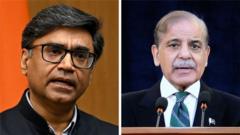As India and Pakistan navigate heightened military confrontations, fears of nuclear escalation loom large. This analysis delves into the strategies, capabilities, and past incidents that underscore the fragile stability in the region.**
The Persistent Shadow: Nuclear Threat Between India and Pakistan**

The Persistent Shadow: Nuclear Threat Between India and Pakistan**
An exploration of the complexities surrounding nuclear tensions between India and Pakistan, highlighting the recent crisis and strategic dynamics.**
Despite the absence of immediate threats, tensions between India and Pakistan remain heightened, with nuclear capabilities casting a long shadow over the subcontinent. Recently, military confrontations—with no direct ultimatums or immediate escalations—underscore the delicate balance maintained through international intervention, primarily by the US.
A recent stand-off, while contained, rekindled concerns over a potential nuclear crisis. U.S. Secretary of State Marco Rubio intervened to ease tensions after Pakistan issued "dual signals"—a military response coupled with a reminder of its nuclear capabilities highlighted through its National Command Authority (NCA).
Both nations possess substantial nuclear arsenals, with estimates placing each at around 170 weapons. As reported by the Stockholm International Peace Research Institute, the global nuclear stockpile had grown to over 12,000 warheads by January 2024, intensifying the stakes of any military confrontation.
India’s nuclear strategy, influenced by its no-first-use policy established after its 1998 tests, has begun to show signs of flexibility, provoking questions about its long-term intentions. In contrast, Pakistan has avoided an official doctrine yet provides insight through its historical statements indicating a readiness to defend its sovereignty.
The potential for nuclear escalation, whether through strategic miscalculations or unexpected incidents, remains a concern. In March 2022, India inadvertently fired a cruise missile into Pakistani territory, an incident that could have escalated rapidly had it occurred during times of heightened tension, leading to significant diplomatic fallout.
Experts posit that, barring major ground confrontations, the risk of nuclear engagement remains limited. This sentiment is echoed by Christopher Clary, who suggests that enduring deterrent strategies prevent the immediate threat of conflict. Additionally, both countries' reluctance to cross the catastrophic nuclear line prevents escalatory actions, as both sides have much to lose in the event of a nuclear exchange.
Nevertheless, advances in nuclear capacities by both nations indisputably raise the danger level. With Pakistan potentially increasing its stockpile and India maintaining a well-structured strategy for nuclear delivery, the long-term risks prompt grave reflections on stability in the region.
In summary, the ongoing complexities of India-Pakistan relations are colored by their nuclear capabilities. While the likelihood of an immediate nuclear conflict appears low, the mere presence of such weapons serves as a constant reminder of the ever-present risks that accompany geopolitical tensions. Balancing deterrents and diplomatic channels remains vital in reducing the specter of nuclear war.
A recent stand-off, while contained, rekindled concerns over a potential nuclear crisis. U.S. Secretary of State Marco Rubio intervened to ease tensions after Pakistan issued "dual signals"—a military response coupled with a reminder of its nuclear capabilities highlighted through its National Command Authority (NCA).
Both nations possess substantial nuclear arsenals, with estimates placing each at around 170 weapons. As reported by the Stockholm International Peace Research Institute, the global nuclear stockpile had grown to over 12,000 warheads by January 2024, intensifying the stakes of any military confrontation.
India’s nuclear strategy, influenced by its no-first-use policy established after its 1998 tests, has begun to show signs of flexibility, provoking questions about its long-term intentions. In contrast, Pakistan has avoided an official doctrine yet provides insight through its historical statements indicating a readiness to defend its sovereignty.
The potential for nuclear escalation, whether through strategic miscalculations or unexpected incidents, remains a concern. In March 2022, India inadvertently fired a cruise missile into Pakistani territory, an incident that could have escalated rapidly had it occurred during times of heightened tension, leading to significant diplomatic fallout.
Experts posit that, barring major ground confrontations, the risk of nuclear engagement remains limited. This sentiment is echoed by Christopher Clary, who suggests that enduring deterrent strategies prevent the immediate threat of conflict. Additionally, both countries' reluctance to cross the catastrophic nuclear line prevents escalatory actions, as both sides have much to lose in the event of a nuclear exchange.
Nevertheless, advances in nuclear capacities by both nations indisputably raise the danger level. With Pakistan potentially increasing its stockpile and India maintaining a well-structured strategy for nuclear delivery, the long-term risks prompt grave reflections on stability in the region.
In summary, the ongoing complexities of India-Pakistan relations are colored by their nuclear capabilities. While the likelihood of an immediate nuclear conflict appears low, the mere presence of such weapons serves as a constant reminder of the ever-present risks that accompany geopolitical tensions. Balancing deterrents and diplomatic channels remains vital in reducing the specter of nuclear war.





















